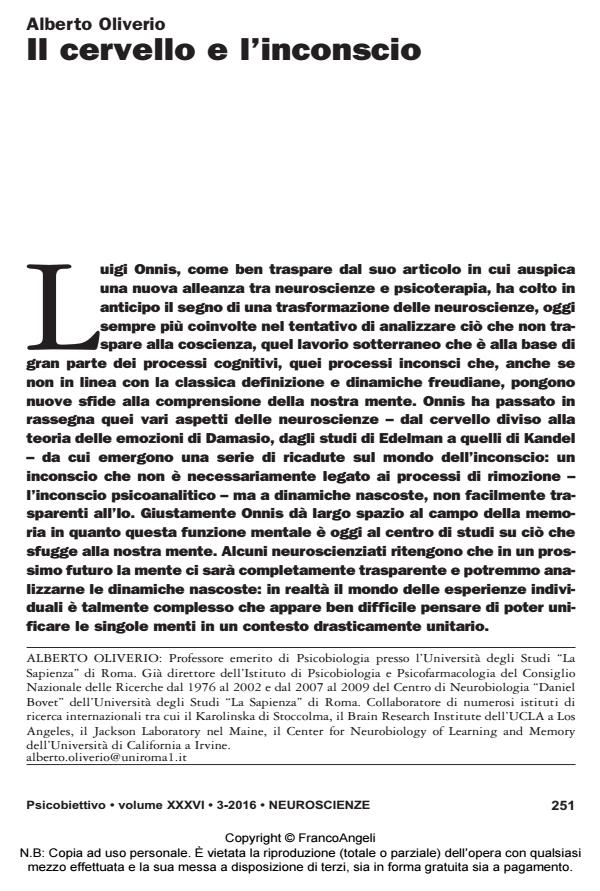The brain and the unconscious
Journal title PSICOBIETTIVO
Author/s Alberto Oliverio
Publishing Year 2016 Issue 2016/3 Language Italian
Pages 9 P. 251-259 File size 91 KB
DOI 10.3280/PSOB2016-003015
DOI is like a bar code for intellectual property: to have more infomation
click here
Below, you can see the article first page
If you want to buy this article in PDF format, you can do it, following the instructions to buy download credits

FrancoAngeli is member of Publishers International Linking Association, Inc (PILA), a not-for-profit association which run the CrossRef service enabling links to and from online scholarly content.
Many executive functions, from memory to decisional processes, have an unconscious dimension that emerges from a series of clinical trials. The unconscious component of many cognitive processes is nowadays the focus of several neuroscientific studies. For example, it is now well understood that it is possible to track down and use a past experience without being aware of making use of pre-existing memories. A very clear case are the implicit memories, including the procedural memory, which is linked to "knowing how" rather than to "describing how" of the semantic memory. Psychoanalysis has had a considerable influence in directing neuroscientists to many research areas, although it must be reckoned that between the two disciplines there are numerous discrepancies, that the methodological differences are deep, and that language is very different. The fact remains that, even with a different view and methodological approaches, neuroscience are exploring aspects of the mind that, for a long time, have been neglected or considered of minor importance in the context of a reductionist approach.
Keywords: Neuroscience; Consciousness; Perception; Memory; Unconscious
- Ansermet F., Magistretti P. (2004) A chacun son cerveau, Odile Jacob, Parigi (trad. it.: A ciascuno il suo cervello. Plasticità neuronale e inconscio, Bollati Boringhieri, Torino, 2008)
- Freud S. (1896) “Lettera 52 a Wilhelm Fliess del 6.12.1896”, in Le origini della psicoanalisi, Boringhieri, Torino 1968
- Freud S. (1971) Psicopatologia della vita quotidiana, Bollati Boringhieri, Torino
- Fuster J.M. (2000) “Cortical dynamics of memory”, in International Journal of Psychobiology, 35: 155-164
- Kandel E.R. (2007) “Psicoterapia e sinapsi: l’influenza delle teorie psichiatriche sulla ricerca in neurobiologia”, in Kandel E.R. (a cura di), Psichiatria, psicoanalisi e nuova biologia della mente, Raffaello Cortina, Milano, pp. 39-70
- Lacan J. (1979) Il Seminario. Libro XI, Einaudi, Torino
- Loftus E.F. (1979) Eyewitness testimony, Harvard University Press, Cambridge (MA)
- Oliverio A. (2010) La vita nascosta del cervello, Giunti, Firenze
- Weiskrantz L. (1986) Blindsight: a case study and implications, Oxford University Press
- Weiskrantz L. (1990) Consciousness lost and found. A neuropsychological exploration, Oxford University Press, 1997; “Problems of learning and memory: one or multiple memory systems?”, in Philosophical Transactions of the Royal Society, London, 329: 1471-2970
- Computational Psychoanalysis and Formal Bi-Logic Frameworks pp.136 (ISBN:9781522541288)
- Computational Psychoanalysis and Formal Bi-Logic Frameworks pp.222 (ISBN:9781522541288)
- Computational Psychoanalysis and Formal Bi-Logic Frameworks pp.1 (ISBN:9781522541288)
- Computational Psychoanalysis and Formal Bi-Logic Frameworks pp.38 (ISBN:9781522541288)
Alberto Oliverio, Il cervello e l’inconscio in "PSICOBIETTIVO" 3/2016, pp 251-259, DOI: 10.3280/PSOB2016-003015